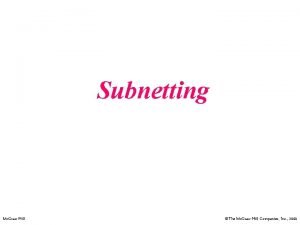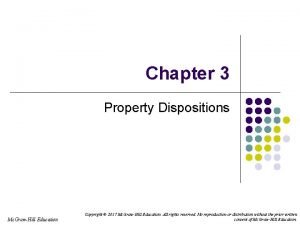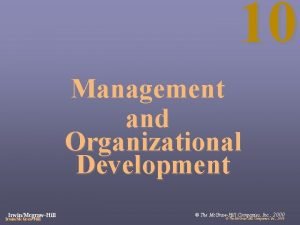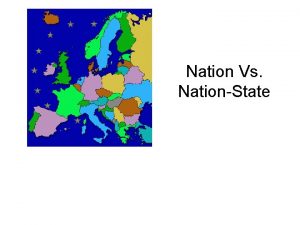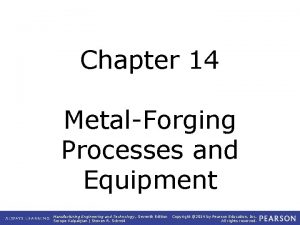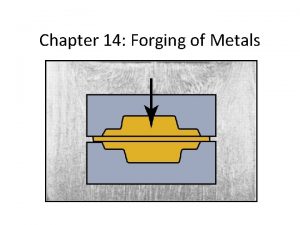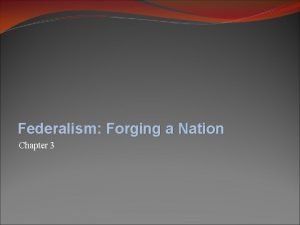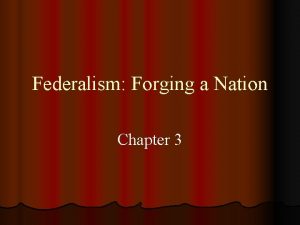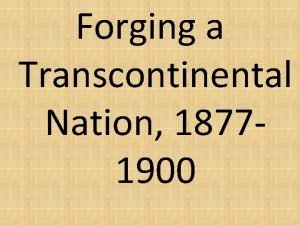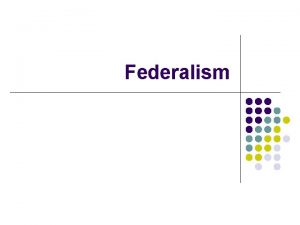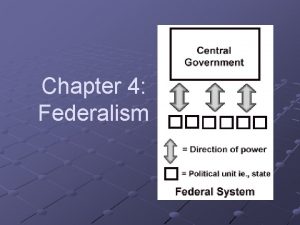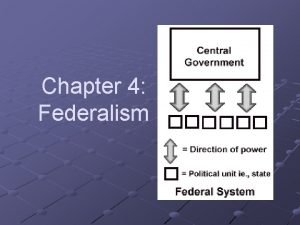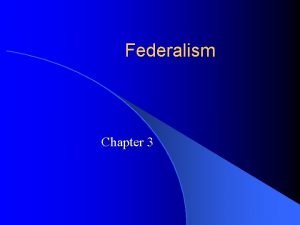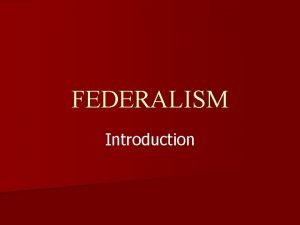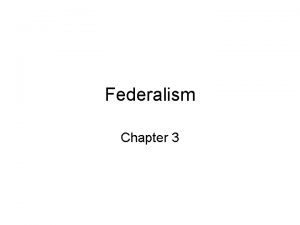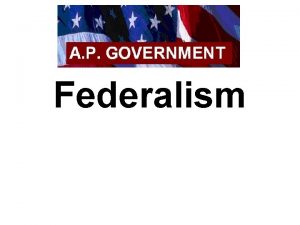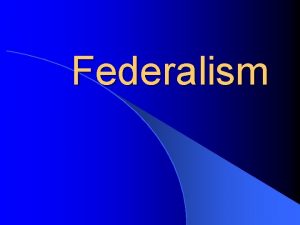3 Federalism Forging a Nation Mc GrawHill Education






















- Slides: 22

3: Federalism Forging a Nation ©Mc. Graw-Hill Education.

The Power of the Federal Government Based on surveys conducted between 2009 and 2015, Americans who identify with the Republican Party are far more likely than Democratic identifiers to believe that the federal government has “too much power. ” ©Mc. Graw-Hill Education. Source: Gallup polls.

Federalism: National and State Sovereignty • Sovereignty: supreme and final governing authority • Systems that apportion governmental power: – Unitary system: the national government is sovereign – Confederacy: the states alone are sovereign – Federalism: sovereignty is shared by the national government and the states ©Mc. Graw-Hill Education.

The Argument for Federalism • Problems with a too-weak national government: – Public disorder – Economic chaos – Inadequate defense • New federal system would divide power among two levels: national and state – – ©Mc. Graw-Hill Education. Protect liberty Moderate government power through sharing Strengthen the union Promote more responsive government

The Powers of the Nation and the States • Enumerated (expressed) powers: power granted to the national government in the Constitution – Seventeen powers, including measures for a secure defense and stable economy – Supremacy clause: national laws were the supreme law of the land • Implied powers: powers of the national government not expressly written but related to those that are listed – “Necessary and proper” clause, or elastic clause: power to make laws in support of enumerated (expressed) powers ©Mc. Graw-Hill Education.

The Powers of the Nation and the States (2) • Reserved powers: the states’ powers under the Constitution – Tenth Amendment: “The powers not delegated to the United States by the Constitution, nor prohibited by it to the States, are reserved to the States” • Nationalization: the gradual shift in power from the states to the national government ©Mc. Graw-Hill Education.

National powers Concurrent powers State powers National defense Currency Post office Foreign affairs Interstate commerce Lend and borrow money Taxation Law enforcement Charter banks Transportation Charter local governments Education Public safety Registration and voting Intrastate commerce Figure 3 -1 Federalism as a Governing System: Examples of National, State, and Concurrent Powers The American federal system divides sovereignty between a national government and the state governments. Each is constitutionally protected in its existence and authority, although their powers overlap somewhat even in areas granted to one level (for example, the federal government has a role in education policy). ©Mc. Graw-Hill Education.

Federalism in Historical Perspective • Ambiguities in the Constitution have contributed to conflict between nation and states – Interstate and intrastate commerce • Federalism has progressed through three historical eras that each ended with a national government stronger than before ©Mc. Graw-Hill Education.

An Indestructible Union (1789– 1865) • Nationalist view: Mc. Culloch v. Maryland (1819), a clear ruling in favor of national power and the supremacy clause • States’ rights view: the Dred Scott decision (1857), a ruling for states’ rights in conflict over the legality of slavery • Civil War settled the issue in favor of national authority ©Mc. Graw-Hill Education.

Dual Federalism and Laissez-Faire Capitalism (1865– 1937) • Dual federalism: the separation of national and state authority was both possible and desirable • Over time, the Fourteenth Amendment was interpreted to give the states discretion • Supreme Court also limited the national power to regulate business and industry • National authority ultimately prevailed as the Supreme Court approved Franklin Roosevelt’s New Deal economic and social programs ©Mc. Graw-Hill Education.

Contemporary Federalism (Since 1937) • Dual federalism is no longer an accurate description • Larger trend: a long-term expansion of national authority – National government now operates in many policy areas once within the control of states and localities • More recent development: devolution, the attempt to “pass down” authority to the state and local levels in selected areas ©Mc. Graw-Hill Education.

Interdependency and Intergovernmental Relations • Cooperative federalism: shared policy responsibilities – National, state, and local levels work together – Joint funding, administration, and determination of programs – Example: Medicaid ©Mc. Graw-Hill Education.

Government Revenues and Intergovernmental Relations • Fiscal federalism: federal funds are used for state programs • Grants-in-aid: cash payments to states and localities • Categorical grants: federal funds restricted to certain state programs • Block grants: federal funds for state programs addressed to a general concern ©Mc. Graw-Hill Education.

Figure 3 -2 Federal, State and Local Shares of Government Tax Revenue The federal government raises as much tax revenues as do all state and local governments combined. ©Mc. Graw-Hill Education. Source: U. S. Department of Commerce, 2016.

Figure 3 -3 Federal Grants to State and Local Governments Federal aid to states and localities has increased dramatically since the 1950 s—from less than 50 billion dollars in 1955 to close to 225 billion in 1880. Aid then declined somewhat, but has been on the rise since the 1990 s. Note: Figures are based on constant (2005) dollars to control for effects of inflation. Figure for each year is the average per year for previous five years. Figure for 2020 is based on OMB estimates. ©Mc. Graw-Hill Education. Source: Office of Management and Budget (OMB), FY 2017.

Federal Grants-in-Aid to the States Federal assistance accounts for a significant share of general state revenue. Note: Not included here is restricted revenue, which is revenue that is designated for a specific purpose, such as property tax designated for use in funding local schools. Jump to long image description ©Mc. Graw-Hill Education. Source: U. S. Census Bureau, 2016.

Devolution • Devolution: the idea that American federalism can be strengthened by a partial shift of power from the national government to the states – Belief held more strongly by Republicans than Democrats – Dramatically increased after the Republican victories of 1994 • Supreme Court has advanced devolution, especially in the latter decades of the twentieth century • Movement waned with the attacks of 9/11 and creation of the Department of Homeland Security; and with the passage of health care reform in 2010 ©Mc. Graw-Hill Education.

The Public’s Influence: Setting the Boundaries of Federal–State Power • Major changes in federalism have been driven by a shift in public support to one level of government or the other – Roosevelt’s “New Deal”—jobs during the Great Depression – Lyndon Johnson’s “Great Society”—increased social services in the 1960 s – Republican Revolution—rolled back federal authority in the 1990 s ©Mc. Graw-Hill Education.

Critical Thinking • Distinguish between a federal system, a unitary system, and a confederacy. What circumstances led the framers of the Constitution to create a federal system? • Contrast dual federalism and cooperative federalism. Is the distinction between a layer cake and a marble cake useful in explaining the difference between dual federalism and cooperative federalism? ©Mc. Graw-Hill Education.

Critical Thinking (2) • How have the federal government’s superior taxing policy and the economic interdependency of the American states contributed over time to a larger policy role for the national government? What role have federal grants-in-aid played in the expansion of federal authority? ©Mc. Graw-Hill Education.

Long image descriptions APPENDIX A ©Mc. Graw-Hill Education

Federal Grants-in-Aid to the States Appendix • States in which federal grants-in-aid account for 35% or more of state revenue include Alabama, Arizona, Georgia, Kentucky, Louisiana, Maine, Mississippi, Missouri, Montana, New Mexico, Oklahoma, Oregon, South Dakota, Tennessee, and Wyoming. • States in which federal grants-in-aid account for 30– 34. 9% of state revenue include Arkansas, Florida, Idaho, Indiana, Iowa, Maryland, Michigan, Nebraska, New York, North Carolina, Ohio, Pennsylvania, Rhode Island, South Carolina, Texas, Utah, Vermont, and West Virginia. • States in which federal grants-in-aid account for 30% or less of state revenue include Alaska, California, Colorado, Connecticut, Delaware, Hawaii, Illinois, Kansas, Massachusetts, Minnesota, Nevada, New Hampshire, New Jersey, North Dakota, Virginia, Washington, and Wisconsin. Jump back to slide containing original image ©Mc. Graw-Hill Education.
 Grawhill
Grawhill Grawhill
Grawhill Grawhill
Grawhill Grawhill
Grawhill Mc graw hill
Mc graw hill Single user multitasking os
Single user multitasking os Grawhill
Grawhill Mc grawhill
Mc grawhill Grawhill
Grawhill Nation state vs nation
Nation state vs nation State vs nation
State vs nation Nation vs nation state
Nation vs nation state Forging adalah
Forging adalah Forging
Forging Pengertian forging
Pengertian forging Wholesale cold forming metal
Wholesale cold forming metal Flashless forging process
Flashless forging process Hubbing forging
Hubbing forging Flashless forging process
Flashless forging process Flashless forging process
Flashless forging process Barrelling in forging
Barrelling in forging Forged vs cast vs billet
Forged vs cast vs billet Flashless forging process
Flashless forging process



